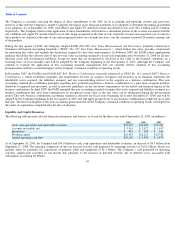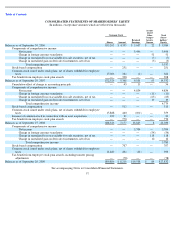Apple 2009 Annual Report Download - page 54
Download and view the complete annual report
Please find page 54 of the 2009 Apple annual report below. You can navigate through the pages in the report by either clicking on the pages listed below, or by using the keyword search tool below to find specific information within the annual report.
Table of Contents
and build product based on demand information supplied by the Company, which typically covers periods ranging from 30 to 150 days. The
Company also obtains individual components for its products from a wide variety of individual suppliers. Consistent with industry practice, the
Company acquires components through a combination of purchase orders, supplier contracts, and open orders based on projected demand
information. Such purchase commitments typically cover the Company’
s forecasted component and manufacturing requirements for periods
ranging from 30 to 150 days. In addition, the Company has an off-
balance sheet warranty obligation for products accounted for under
subscription accounting whereby the Company recognizes warranty expense as incurred. As of September 26, 2009, the Company had
outstanding off-balance sheet third-
party manufacturing commitments, component purchase commitments and estimated warranty commitments
of $4.8 billion.
The Company has entered into prepaid long-
term supply agreements to secure the supply of certain inventory components. During the first
quarter of 2009, a long-
term supply agreement with Intel Corporation was terminated and the remaining prepaid balance of $167 million was
repaid to the Company. During the second and fourth quarters of 2009, the Company made a prepayment of $500 million to LG Display for the
purchase of LCD panels and a prepayment of $500 million to Toshiba to purchase NAND flash memory, respectively. As of September 26,
2009, the Company had a total of $1.2 billion of inventory component prepayments outstanding.
Asset Retirement Obligations
The Company’
s asset retirement obligations are associated with commitments to return property subject to operating leases to original condition
upon lease termination. As of September 26, 2009, the Company estimated that gross expected future cash flows of $32 million would be
required to fulfill these obligations.
Other Obligations
Other outstanding obligations were $356 million as of September 26, 2009, which related to advertising, research and development, Internet and
telecommunications services and other obligations.
As of September 26, 2009, the Company had gross unrecognized tax benefits of $971 million and an additional $291 million for gross interest
and penalties classified as non-
current liabilities in the Consolidated Balance Sheet. The Company believes it is reasonably possible that tax
audit resolutions could reduce its unrecognized tax benefits by between $105 million and $145 million in the next 12 months. At this time, the
Company is unable to make a reasonably reliable estimate of the timing of payments in individual years due to uncertainties in the timing of tax
audit outcomes; therefore, such amounts are not included in the above contractual obligation table.
Indemnifications
The Company generally does not indemnify end-
users of its operating system and application software against legal claims that the software
infringes third-
party intellectual property rights. Other agreements entered into by the Company sometimes include indemnification provisions
under which the Company could be subject to costs and/or damages in the event of an infringement claim against the Company or an
indemnified third-
party. However, the Company has not been required to make any significant payments resulting from such an infringement
claim asserted against it or an indemnified third-
party and, in the opinion of management, does not have a liability related to unresolved
infringement claims subject to indemnification that would materially adversely affect its financial condition or operating results. Therefore, the
Company did not record a liability for infringement costs as of either September 26, 2009 or September 27, 2008.
The Company has entered into indemnification agreements with its directors and executive officers. Under these agreements, the Company has
agreed to indemnify such individuals to the fullest extent permitted by law against liabilities that arise by reason of their status as directors or
officers and to advance expenses incurred by such
51
























